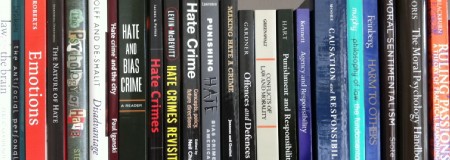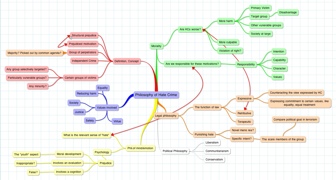the Philosophy of Hate Crime Map
25 september 2011 | In Hate Crime | Comments?Should perhaps be framed by areas marked ”Here be Dragons”.
The Philosophy of Hate Crime Symposium
25 september 2011 | In academia Hate Crime Moral philosophy politics Self-indulgence | Comments?Tomorrow it starts: the Philosophy of Hate Crime Symposium, the 2nd in a series of symposia in the When Law and Hate Collide project. The Symposium, as far as I know, is the first to concentrate on philosophical aspects of Hate Crime and Hate Crime Legislation. (There has been a Law and Philosophy special issue, however, on Hate Crime Legislation back in 2001).
It is also quite unique insofar as, amazingly, I’m hosting it.
It is a symposium about hate. As a counter-weight to that other, more famous, 2400 year old symposium.
Here’s the schedule. As you can see, it’s all very interesting stuff
Monday 26/9
Introduction: How Law and Hate Collide
Mark Cutter, University of Central Lancashire and Christian Munthe, University of Gothenburg
Moving Beyond “Hate” Crime
Barbara Perry, Department of Social Science and Humanities, University of Ontario Institute of Technology
How hate hurts. The moral philosophical basis of ‘hate crime’ laws
Paul Iganski, Department of Applied Social Science, Lancaster University
Targeting Vulnerability: A Fresh Set of Challenges for Hate Crime Scholarship and Policy?
Neil Chakraborti, Department of Criminology, University of Leicester
The OSCE and its Work on Hate Crime
Joanna Perry OSCE
Panel Discussion
Tuesday 27/9
Criminalizing Hate, Criminalizing Character
Heidi Hurd, University of Illinois, College of Law
Hate as an Aggravating Factor in Sentencing
Mohamad Al Hakim, Department of Philosophy, York University
Two Kinds of Expressive Harm
Antti Kauppinen, Department of Philosophy, Trinity College Dublin
Philosophy of Hate Crime – a Conceptual Framework – Morality, Law and Public Policy
David Brax and Christian Munthe, Department of Philosophy, Linguistics and Theory of Science, University of Gothenburg
General Discussion
The symposium will be filmed and made available to the public as soon as possible. Watch the upcoming webpage: www.h8crime.eu
Hate Crime and Interchangeability
20 september 2011 | In Crime Hate Crime politics Psychology | Comments?Hate and Interchangeability
A key concept in distinguishing Hate Crimes from other crimes is Interchangeability. This seems to be a main feature of group hatred: treating members of the target group as interchangeable: any person belonging to that group could be selected. In their 2002 book Hate Crimes Revisited Levin and McDevitt argue that this means that there is an amount of randomness in these crimes. Any bearer of the targeted characteristic is a potential victim, and this is at least partly why the psychological impact of hate crimes on the targeted group is so severe. Systematically ”random” acts of violence influence the feeling of security of populations more widely then does, say, violence between criminal gangs.
The hate in hate crime is generalized hate, it is not intended to encompass hatred for individual persons based on individual characteristics. But it is not entirely general: the crime cannot be totally random, the victim not, totally interchangeable. Then it will not be a hate crime. Two types of hate motivations then seem to fall out of the hate crime picture
1) The perpetrator does not hate black people, just this person
2) The perpetrator does not hate black people, but all people
If the psychological effects of random acts of violence are such as Levin and McDevitt suppose, then, presumably, the latter alternative should be even worse. Or possibly we are not that bothered by complete randomness (we are very unlikely victims), but by randomness within a smaller group to which we belong, either because we are more likely victims (our feeling of insecurity would then be inversely proportional to the size of the group) or because we sympathize more with victims of our own group.
The Central Park Jogger
In the highly publicized ”The Central Park Jogger Case” back in 1989 these sorts of considerations came into view. The victim, a 28 year old white female investment banker, was jogging in central park when she was assaulted, raped and beaten nearly to death by a gang of youths. Evidence suggesting that she was targeted because she was female, or upper middle-class, poured in, suggesting race-, gender- or class-based hatred. But so did evidence that the gang was looking for a random victim, based for instance on earlier assaults by the gang. Interchangeability, then, plays a double role here:
1) Would they have assaulted anyone coming along at that time?
2)Would they have assaulted any woman/ white person /investment banker?
There is an important discussion going on whether rapes should more commonly be understood as gender-based hate crimes, circling around this question: is the hate involved general enough? Is the reasons for targeting women exclusively reducible to gender-hatred?
Hate and acquaintance
Hate crimes are normally understood as being committed by a member of one group against a member of another, distinct group. Recorded hate crimes tend to be cases where the victim and the perpetrator does not know each other. This is in contrast to other types of crimes (Levin and McDevitt, again). But while this is so, it might be due to how we conceptualize and understand hate crimes. If there is a personal relation between victim and perpetrator, we are less likely to understand the hatred as generalized. Spousal abuse, while terrifyingly common, seems to be understood as based in the particulars of the relation, and thus does not qualify as hate crimes. The interchangeability condition is not satisfied in the ”right” way. Alternatively, it is too difficult to distinguish the general from the particular in crimes within personal relations.
This might mean that hate crime legislation has a blind spot, however. In a recent report from RFSL (The Swedish Federation for Lesbian, Gay, Bisexual and Transgender Rights) about ”HBT and Honour”, it is pointed out that many HBT-people are assaulted by family members because of their group membership. Even if this too involves violence between distinct groups, being distinct in one characteristic is compatible with being overlapping in others, such as family membership.
Group hatred may drive violence even within personal relations. Many instances of rape, even in relationships or between acquaintances, may be caused by gender-based hatred. It is hard, however, to show the interchangeability aspect in acquaintance cases. This may also mean, rightly or wrongly, that the self-interested psychological effects of perceived randomness does not occur when we are informed about these crimes.
Expanding the Label
Should the hate crime label be attached to a wider set of cases? Would the victims of assaults within a family, say, or victims of rape, benefit from being recognized as the victims of hate crime? While perceived ”randomness” may mean that more people will feel threatened by the occurrence of these crimes, it might also provide some solace to the victim: the assault was, in fact, nothing personal. It could have happened to anyone.
But these are complicated psychological matters: It depends on how much I identify with the relevant group membership – being targeted because of being female, say, might not feel ”random” at all, but strike at the very heart of my identity. Even if I do feel it’s random, this very fact may make the event ”senseless”, and I may feel even more unfortunate because it happened to me for no particular reason. Some victims may benefit from finding some ”meaning” in the assault, but others may suffer from it. Especially in cases of rape, ”blaming the victim”, even by the victim her/him-self may seem to make sense of the particular assault, but result in more suffering. And making sense of the particular assault by focusing on the characteristics of the perpetrator, especially if the victim stands in a close personal relationship to him/her, may tie them closer together, at great personal cost.
If the Hate Crime label is effective in offering support and protection to especially vulnerable, disadvantaged or frequently targeted groups, there seems to be no objection to expanding it to cover cases which may at the surface look as instances of personal hostility. Whether it is effective in this regard is another question.
The Books
16 september 2011 | In academia Books Hate Crime | Comments?
I know, one should not show ones workings but ain’t it pretty? It seems each project I’m sort of in, or propose, or dream about generates a small library. They overlap considerably, which is a good thing considering the limited dimensions of time and space allocated to mortals.
